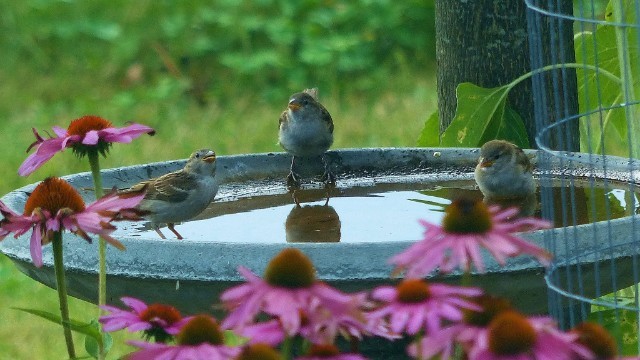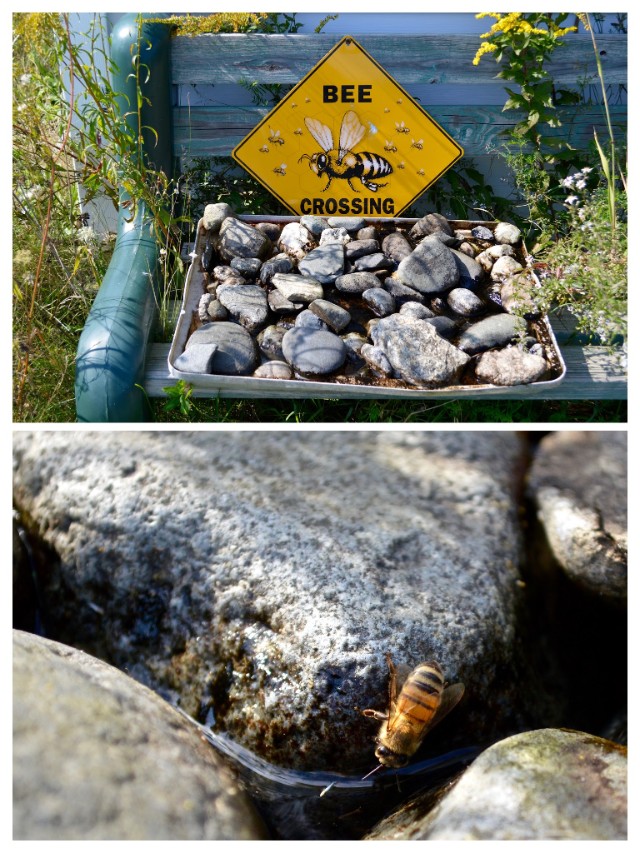August—oh how I love this month in Maine! Fewer bug bites, warm days, and cool nights for perfect sleeping weather. Drifting off to dreamland with the peaceful sound of cricket song and a cool evening breeze through open windows just can’t be beat. It’s been so unbearably hot. Cooler evening temperatures can’t come soon enough, right?
As late summer approaches, this is the perfect time to take stock of the season and re-visit your bucket list. What’s that one thing you really want to do this summer, but haven’t yet?
I just finished a beautiful habitat design for a residential property in Brunswick and can hardly wait to see it planted! I partnered with Larkspur Design on this project for their hand drawing and landscape design expertise. We are looking forward to partnering on many more projects in the future and I’ll be adding their profile to a new “My Team and Our Partners” page on my website soon.
In today’s blog, I offer three ways you can provide wildlife with access to water, an incredibly important and timely topic after the dry spring and summer we’ve had. It doesn’t have to be expensive or complicated, either…
Water for Wildlife — Even a “Wee Bit” Makes a Big Difference
It’s easy to overlook water as a critical feature in your wildlife-friendly landscape, especially here in the Northeast where water is relatively abundant. However, access to water can be a very limiting factor in an otherwise high-quality habitat with abundant food, cover, and shelter.
This time of year adequate water can be hard to come by, particularly for species that may occupy a small local area, such as pollinators, songbirds, reptiles, and amphibians. In the wintertime, water can be largely inaccessible due to frozen conditions.
“Providing clean water at the proper level in the correct habitat at the right time of year is one of the most useful management tools for attracting birds and improving wildlife habitat.” —The Audubon Society Guide to Attracting Birds

Photo: plant4wildlife on Flickr
Providing water can be something as simple as re-purposing a garbage can lid to building an elaborate wildlife pond.
Assess your landscape needs, budget and resources (time and money) and take the next step providing water for wildlife today – at any scale.
See 3 ways below.
Work with me to get customized recommendations for providing better food, water, cover, and shelter for wildlife on your unique plot of land.
Three Wonderfully Different Ways to Provide Water for Wildlife
1. A (Better) Birdbath – not just a pretty one!
Birdbaths provide safe, year-round access to clean, open water when properly maintained and sited. A simple birdbath is a low-cost, easy maintenance way to provide birds with water for bathing and drinking. Your birdbath should:
- be no deeper than 3″,
- have gently sloping sides/edges (many manufactured bird baths have sides that are too steep),
- have a textured surface,
- be free of algae, bacteria and mosquito larvae (clean with mild soap once a week),
- be heated in the winter (you can purchase a heated birdbath or add a heater to an existing one), and
- be safe from predators. If house or stray cats are in the area, choose a raised bird bath, at least 3′ off the ground, and place it in the open and at least 15′ away from shrubs. The best scenario is to keep your cats indoors, which will allow you to attract more secretive birds like warblers, vireos, and wood thrushes that prefer bathing in tucked away areas near shrubs and trees. Also, keep in mind that ground-level baths better mimic natural puddles and are likely to attract more species. Therefore, if cat predation is not an issue think about constructing a birdbath on the ground with a metal garbage can lid and other everyday materials. For more information, drop me a line!
2. Provide Pollinators with A Wee Drink!
Many pollinators need a water source beyond what they acquire from nectar. A shallow tray of water and stones will allow bees and butterflies to safely drink (see photo below). Birdbaths are generally too wide and deep for bees. You can add corks and stones to a shallow bird bath for bees as well. To limit mosquito breeding, just change the water every five days or so.
3. Build a Pond…or a Natural Swimming Pool!
A small backyard frog pond, or a larger wildlife pond will greatly enhance the habitat value of a property, especially when done well.
- If you are serious about pursuing this, consider ordering this book from your local bookstore: Building Natural Ponds: Create a Clean, Algae-free Pond without Pumps, Filters, or Chemicals by Robert Pavlis
- If you have a bigger budget for aquatic habitat design—or just want to “ooh” and “aah” over the pictures in the gallery—check out Robin’s Nest LLC based in Hollis. Christopher Paquette has deep experience and works with homes and businesses to design and install many types of water features from water gardens and fountains to natural swimming pools. In my mind, a natural swim pond is the ultimate, oh-so-dreamy double-duty water feature that will provide habitat as well as beautiful, clean water for swimming! One can always dream, right?!

Drinking station for bees at Highland Organics®, Inc & Highland Blueberry Farm. Photo courtesy of MOFGA
Now is the perfect time to hire me to build your dream landscape—NOT in the spring!
Unfortunately, it is quite common for people to call me in the spring with hopes of a quick turnaround, but design work, habitat planning, plant sourcing, and lining up contractors takes time to do it right. NOW is the perfect time to plan that gorgeous pollinator garden, habitat hedgerow, or forest bird sanctuary. I can work on your design or habitat plan during the winter months, and we’ll be ready to make it a reality this spring! Book a Customized Habitat Design between now and November 1st and we will provide you with a discount of 10% off. Just mention the “planning ahead discount” when you book.











Leave a Reply